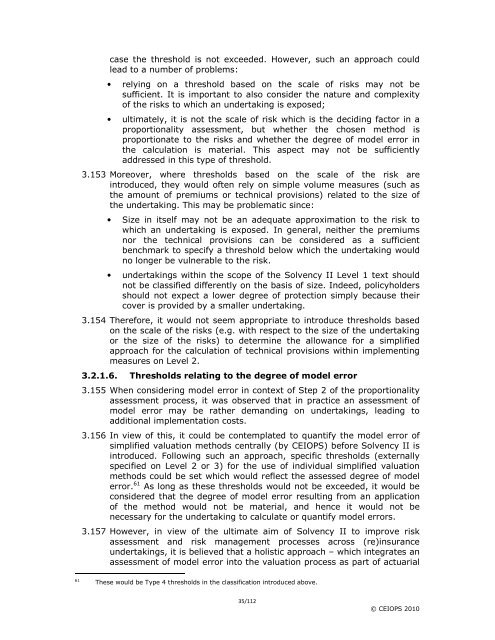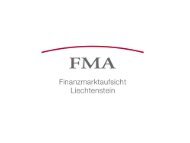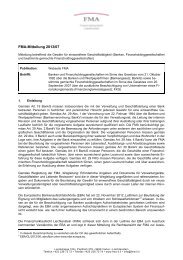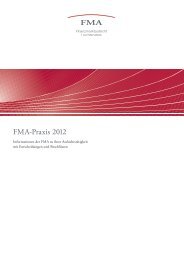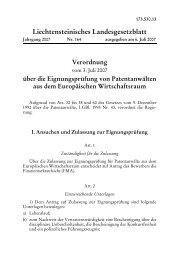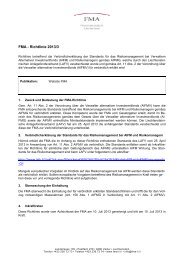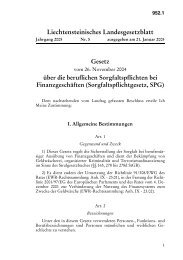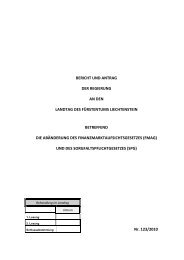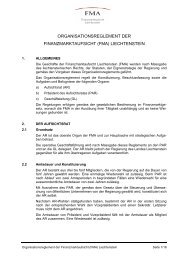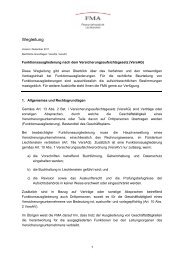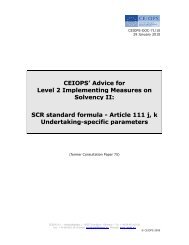CEIOPS' Advice for Level 2 Implementing ... - EIOPA - Europa
CEIOPS' Advice for Level 2 Implementing ... - EIOPA - Europa
CEIOPS' Advice for Level 2 Implementing ... - EIOPA - Europa
You also want an ePaper? Increase the reach of your titles
YUMPU automatically turns print PDFs into web optimized ePapers that Google loves.
case the threshold is not exceeded. However, such an approach could<br />
lead to a number of problems:<br />
• relying on a threshold based on the scale of risks may not be<br />
sufficient. It is important to also consider the nature and complexity<br />
of the risks to which an undertaking is exposed;<br />
• ultimately, it is not the scale of risk which is the deciding factor in a<br />
proportionality assessment, but whether the chosen method is<br />
proportionate to the risks and whether the degree of model error in<br />
the calculation is material. This aspect may not be sufficiently<br />
addressed in this type of threshold.<br />
3.153 Moreover, where thresholds based on the scale of the risk are<br />
introduced, they would often rely on simple volume measures (such as<br />
the amount of premiums or technical provisions) related to the size of<br />
the undertaking. This may be problematic since:<br />
• Size in itself may not be an adequate approximation to the risk to<br />
which an undertaking is exposed. In general, neither the premiums<br />
nor the technical provisions can be considered as a sufficient<br />
benchmark to specify a threshold below which the undertaking would<br />
no longer be vulnerable to the risk.<br />
• undertakings within the scope of the Solvency II <strong>Level</strong> 1 text should<br />
not be classified differently on the basis of size. Indeed, policyholders<br />
should not expect a lower degree of protection simply because their<br />
cover is provided by a smaller undertaking.<br />
3.154 There<strong>for</strong>e, it would not seem appropriate to introduce thresholds based<br />
on the scale of the risks (e.g. with respect to the size of the undertaking<br />
or the size of the risks) to determine the allowance <strong>for</strong> a simplified<br />
approach <strong>for</strong> the calculation of technical provisions within implementing<br />
measures on <strong>Level</strong> 2.<br />
3.2.1.6. Thresholds relating to the degree of model error<br />
3.155 When considering model error in context of Step 2 of the proportionality<br />
assessment process, it was observed that in practice an assessment of<br />
model error may be rather demanding on undertakings, leading to<br />
additional implementation costs.<br />
3.156 In view of this, it could be contemplated to quantify the model error of<br />
simplified valuation methods centrally (by CEIOPS) be<strong>for</strong>e Solvency II is<br />
introduced. Following such an approach, specific thresholds (externally<br />
specified on <strong>Level</strong> 2 or 3) <strong>for</strong> the use of individual simplified valuation<br />
methods could be set which would reflect the assessed degree of model<br />
error. 61 As long as these thresholds would not be exceeded, it would be<br />
considered that the degree of model error resulting from an application<br />
of the method would not be material, and hence it would not be<br />
necessary <strong>for</strong> the undertaking to calculate or quantify model errors.<br />
3.157 However, in view of the ultimate aim of Solvency II to improve risk<br />
assessment and risk management processes across (re)insurance<br />
undertakings, it is believed that a holistic approach – which integrates an<br />
assessment of model error into the valuation process as part of actuarial<br />
61 These would be Type 4 thresholds in the classification introduced above.<br />
35/112<br />
© CEIOPS 2010


